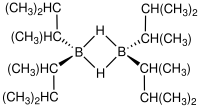Disiamylborane (bis(1,2-dimethylpropyl)borane) is an organoborane with the formula [((CH3)2CHCH(CH3))2BH]2 (abbreviation: Sia2BH). It is a colorless waxy solid that is used in organic synthesis for hydroboration–oxidation reactions. Like most dialkyl boron hydrides, it has a dimeric structure with bridging hydrides.

| |
| Names | |
|---|---|
| IUPAC name
Bis(1,2-dimethylpropyl)borane
| |
| Identifiers | |
3D model (JSmol)
|
|
| ChemSpider | |
PubChem CID
|
|
| UNII | |
CompTox Dashboard (EPA)
|
|
| |
| |
| Properties | |
| C10H23B | |
| Molar mass | 154.09 g/mol |
| Melting point | 35-40 °C |
Except where otherwise noted, data are given for materials in their standard state (at 25 °C [77 °F], 100 kPa).
| |
Reactions
editDisiamylborane is prepared by hydroboration of trimethylethylene with diborane.[1] The reaction stops at the secondary borane due to steric hindrance.
Disiamylborane is relatively selective for terminal alkynes and alkenes vs internal alkynes and alkenes. Like most hydroboration, the addition proceeds in an anti-Markovnikov manner.[1] It can be used to convert terminal alkynes, into aldehydes.
The hydroboration process proceeds via an initial dissociation of the dimer.[2]
Related reagents
edit- 9-Borabicyclo[3.3.1]nonane (9-BBN).
- Thexylborane ((1,1,2-trimethylpropyl)borane, ThxBH2), a primary borane obtained by hydroboration of tetramethylethylene.
Naming
editThe prefix disiamyl is an abbreviation for "di-sec-isoamyl", where sec-isoamyl ("secondary isoamyl") is an archaic name for the 1,2-dimethylpropyl group (amyl being a obsolescent synonym of pentyl).
References
edit- ^ a b Eric J. Leopold (1986). "Selective Hydroboration of a 1,3,7-Triene: Homogeraniol". Organic Syntheses. 64: 164. doi:10.15227/orgsyn.064.0164.
- ^ Chandrasekharan, J.; Brown, Herbert C. (1985). "Hydroboration kinetics. 11. A reinvestigation of the kinetics of hydroboration of representative alkenes with disiamylborane dimer. Conclusive evidence for the dissociation mechanism in the hydroboration of alkenes with dialkylborane dimers". The Journal of Organic Chemistry. 50 (4): 518–520. doi:10.1021/jo00204a019.